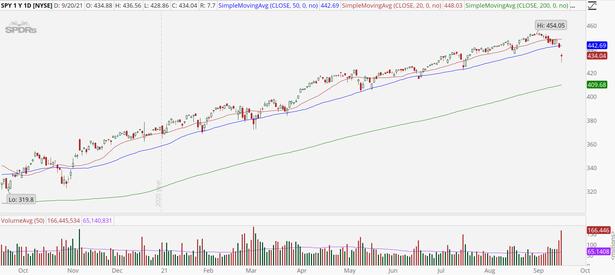Why Is Nvidia (NVDA) Up 1.1% Since Last Earnings Report? Edit My Quotes
A month has gone by since the last earnings report for Nvidia (NVDA). Shares have added about 1.1% in that time frame, outperforming the S&P 500.
Will the recent positive trend continue leading up to its next earnings release, or is Nvidia due for a pullback? Before we dive into how investors and analysts have reacted as of late, let's take a quick look at its most recent earnings report in order to get a better handle on the important catalysts.
NVIDIA reported fourth-quarter fiscal 2022 non-GAAP earnings of $1.32 per share, which beat the Zacks Consensus Estimate by 8.2%. The reported figure jumped 69.2% year over year and 12.8% sequentially.
Revenues of $7.64 billion beat the consensus mark by 2.9% and surged 52.8% year over year. The top line climbed 7.6% on a quarter-over-quarter basis.
The year-over-year top-line growth was driven by higher sales of GeForce Graphic Processing Units (GPUs). NVIDIA continues to benefit from strong demand for its Ampere architecture products.
NVIDIA reports revenues under two segments — Graphics and Compute & Networking.
Graphics includes GeForce GPUs for gaming and personal computers; the GeForce NOW game-streaming service and related infrastructure, besides solutions for gaming platforms; Quadro GPUs for enterprise design; GRID software for cloud-based visual and virtual computing; and automotive platforms for infotainment systems.
Graphics accounted for 57.8% of the fiscal fourth-quarter revenues. The segment’s top line surged 44.6% year over year and 8% sequentially to $4.42 billion.
Compute & Networking represented 42.2% of the fiscal fourth-quarter revenues. The segment comprises Data-Center platforms and systems for AI, high-performance computing, and accelerated computing; DRIVE development platform for autonomous vehicles; and Jetson for robotics and other embedded platforms.
Compute & Networking revenues soared 65.6% year over year and 7.1% sequentially to $3.23 billion.
Based on the market platform, Gaming revenues (44.7% of revenues) shot up 37.1% year over year and 6.2% sequentially to $3.42 billion.
Revenues from Data Center (42.7% of revenues) jumped 71.5% year over year and 11.1% from the previous quarter to $3.26 billion. This year-over-year upswing was driven by strong demand for its Ampere architecture products from cloud computing and AI providers.
Professional Visualization revenues (8.4% of revenues) increased a whopping 109.4% year over year and 11.4% sequentially to $643 million. This growth mainly resulted from increased sales of notebook workstation GPUs and the ramp-up of Ampere architecture GPUs.
Auto revenues (1.6% of revenues) in the reported quarter totaled $125 million, down 13.8% on a year-over-year basis and 7.4% sequentially. The segment suffered from supply constraints.
OEM and Other revenues (2.5% of revenues) climbed 25.5% year over year to $192 million. Cryptocurrency Mining Processors’ revenues under the market platform were $24 million. However, the division’s sales declined 17.9% on a quarter-on-quarter basis.
NVIDIA’s non-GAAP gross margin expanded 160 basis points (bps) year over year to 67%, mainly on a higher-end mix within the desktop and notebook GeForce GPUs. On a sequential basis, gross margin was flat.

Non-GAAP operating expenses flared up 21.9% year over year and 5.2% sequentially to $1.45 billion on higher compensation-related expenses associated with the employee growth and increased infrastructure costs.
Non-GAAP operating income jumped 76% year over year and 8.6% quarter over quarter to $3.68 billion.
As of Jan 30, 2022, NVIDIA’s cash, cash equivalents and marketable securities were $21.21 billion, up from $19.30 billion as of Oct 31, 2021.
As of Jan 30, 2022, total long-term debt (including current maturities) was $10.95 billion, slightly up from $10.94 billion seen in the previous quarter ended Oct 31, 2021.
NVIDIA generated $3.03 billion in operating cash flows, up from the previous quarter’s $1.52 billion. Free cash flow was $2.74 billion, up from last quarter’s $1.28 billion.
For the first quarter of fiscal 2023, NVIDIA anticipates revenues of $8.10 billion (+/-2%).
Non-GAAP gross margin is projected at 67% (+/-50 bps). Non-GAAP operating expenses are estimated to be $1.60 billion.
How Have Estimates Been Moving Since Then?
In the past month, investors have witnessed an upward trend in estimates review.
The consensus estimate has shifted 9.36% due to these changes.
VGM Scores
At this time, Nvidia has an average Growth Score of C, though it is lagging a lot on the Momentum Score front with an F. Following the exact same course, the stock was allocated a grade of F on the value side, putting it in the bottom 20% quintile for this investment strategy.
Overall, the stock has an aggregate VGM Score of F. If you aren't focused on one strategy, this score is the one you should be interested in.
Outlook
Estimates have been trending upward for the stock, and the magnitude of these revisions looks promising. It comes with little surprise Nvidia has a Zacks Rank #1 (Strong Buy). We expect an above average return from the stock in the next few months.
Just Released: Zacks Top 10 Stocks for 2022
In addition to the investment ideas discussed above, would you like to know about our 10 top picks for the entirety of 2022?
From inception in 2012 through 2021, the Zacks Top 10 Stocks portfolios gained an impressive +1,001.2% versus the S&P 500’s +348.7%. Now our Director of Research has combed through 4,000 companies covered by the Zacks Rank and has handpicked the best 10 tickers to buy and hold. Don’t miss your chance to get in…because the sooner you do, the more upside you stand to grab.
See Stocks Now>>Click to get this free reportNVIDIA Corporation (NVDA): Free Stock Analysis ReportTo read this article on Zacks.com click here.The views and opinions expressed herein are the views and opinions of the author and do not necessarily reflect those of Nasdaq, Inc.








